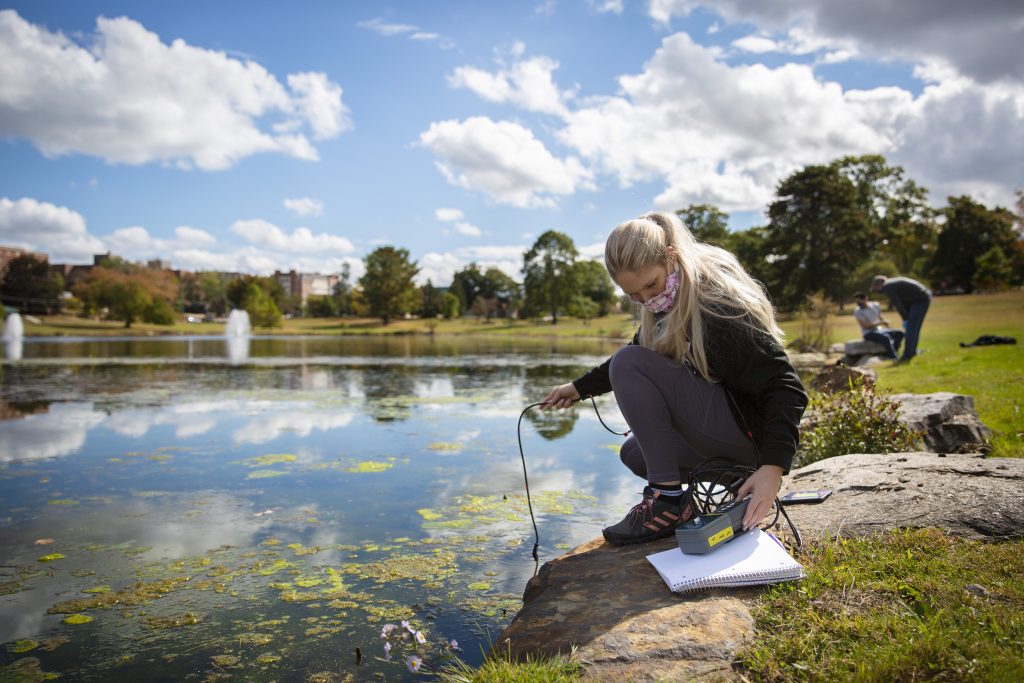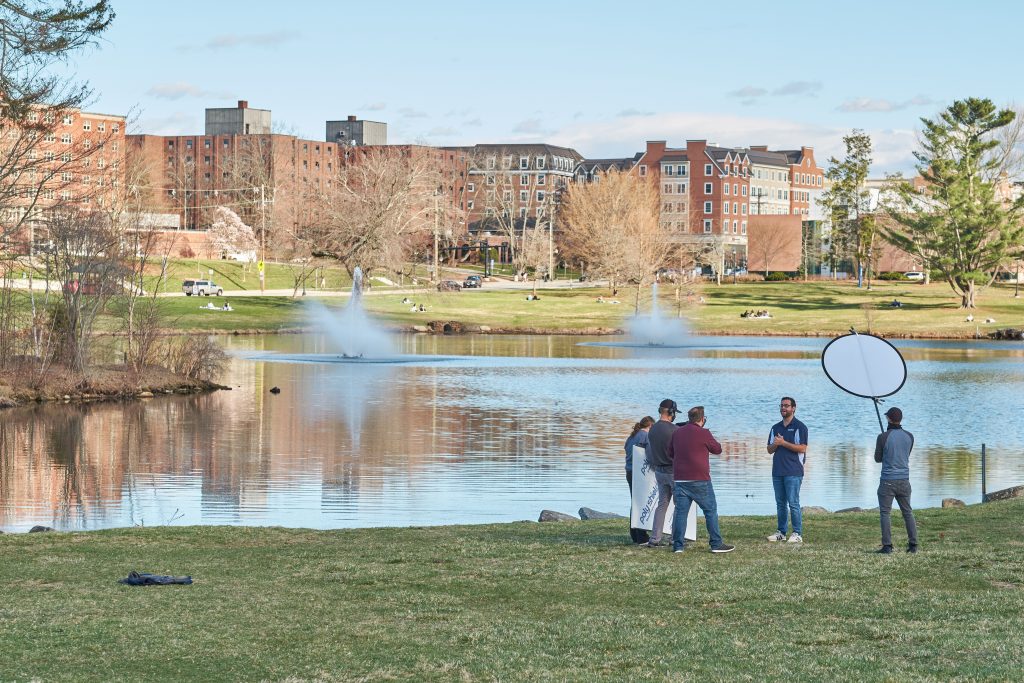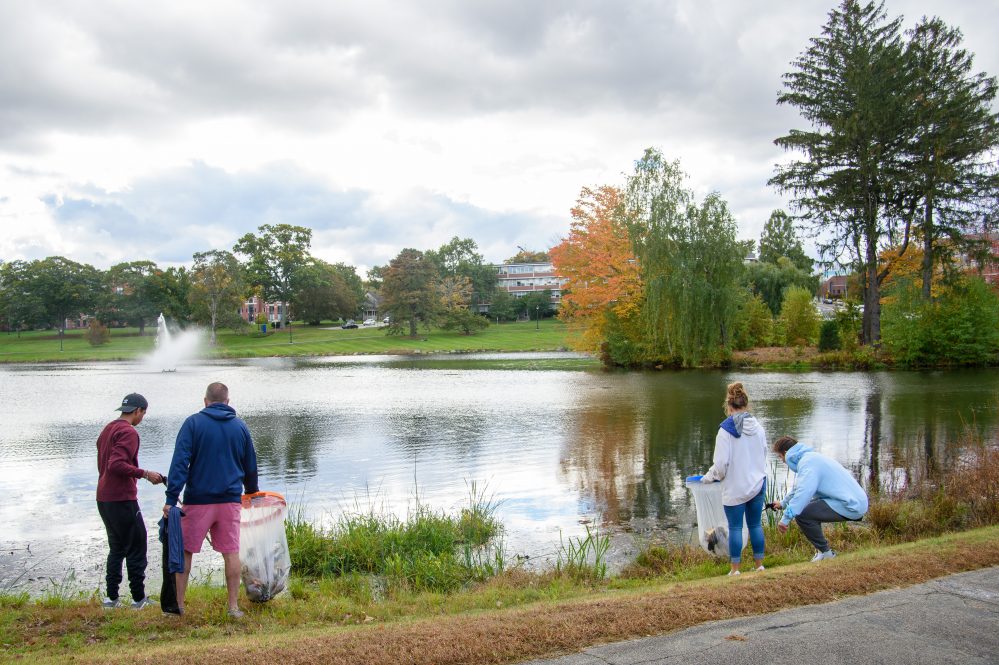UConn is reviewing ways to improve Mirror Lake by addressing critical flood-prevention issues, long-overdue dredging, stormwater management, and the water quality and aesthetics of that highly visible campus attraction.
The work comes after a new drainage master plan and feasibility study determined an immediate need to create more capacity in the increasingly shallow lake to handle stormwater runoff. The lake’s 75-year-old dam would also need to be replaced and its spillway repaired, since dangerous conditions could occur if those flood-control measures fail during extreme rains.
The Board of Trustees voted Wednesday to allow the start of design for the project to get a sense of what would be involved as the concept plan is developed, the potential costs for various options if the University decides to proceed, and other issues.
Mirror Lake is visibly shallow, murky, and excessively weedy during periods of the year and contains several feet of organic muck and sediment. That’s because stormwater from its South Campus watershed and non-UConn property flows toward the lower-lying lake, hurting the water quality and creating less water storage capacity as layers of muck coat the bottom.
The existing dam was last replaced in 1946 and the lake was last dredged in 1970, despite significant growth and development in the watershed since then that has added to the stormwater runoff. Assessments conducted around seven years ago found Mirror Lake’s deepest areas were only about 3.5 feet, suggesting a loss of more than 6 feet of depth due to runoff since the last dredging.
“Mirror Lake is an important historic, functional and cultural landmark beloved by our students, the entire campus community, and the town of Mansfield for nearly 100 years. It really needs and deserves our intervention now more than ever,” says Sean Vasington ’99 (CAHNR), University Landscape Architect and Director of Site Planning and Landscape Architecture for UConn’s University Planning, Design & Construction (UPDC).
Unlike UConn’s Swan Lake to the north, Mirror Lake isn’t a natural water body. It originally was a marshy meadow just off campus when UConn began as the Storrs Agricultural School in 1881, and later became part of the institution’s property.

By 1910, landscape architects already were proposing turning it into a human-made lake, both as an aesthetic feature of the central campus and to find an appropriate use for the otherwise swampy, insect-friendly marsh.
Around 1922, the wooden dam on the marsh’s northern side was removed, a new soil dam was created, and about four acres were flooded to create Mirror Lake. It’s been a central feature of the UConn Storrs campus since then, frequently pictured on postcards and visited by students, alumni, and others as a peaceful spot for studying and reflection.
However, even as affection for the lake has grown, sediment and impurities from the nearby area have flowed into Mirror Lake over decades and coated its bottom with deep layers upon layers of silt and muck.
The soil dam from 1922 was replaced and the lake was dredged in 1946, but water quality issues created by stormwater runoff continued to be exacerbated by waterfowl excrement. Geese and gulls also made it their home, and students often released pet goldfish or ducks in the water at the end of each spring semester.
It was dredged again in fall 1970 so workers could remove silt and shore up the center island, temporarily moving the ducks who remained in the shallow pools of the drained-out lake, according to a Hartford Courant article at the time. But like earlier interventions, the improvements weren’t permanent.
By the 2000s, Mirror Lake’s conditions were again so bad that a mat of algae covered its surface. UConn launched annual maintenance programs, including cleaning and treatments, to combat algae growth. The University also started planning in 2008 to dredge the lake, but the project had to be deferred a few years later due to funding.
The addition of two fountains since 2015 have helped mitigate some of the algae blooms. However, they also circulate the lighter sediment, which can suspend in the water and create even murkier conditions until the next heavy rainfall temporarily washes it clean.
With more than 6 feet of depth lost since the last dredging, Mirror Lake and its dam struggle today to contain water from heavy rainfalls. In fact, during some of last summer’s heaviest storms, water regularly flowed over the banks of the brook originating at the dam’s spillway and became temporarily impounded at downstream culverts.
UConn took over dam inspection and assessment processes in 2016 from the state Department of Energy & Environmental Protection (DEEP) due to changes to Connecticut dam safety regulations.
After its 2019 assessment, Mirror Lake’s dam was deemed a higher safety hazard than before, moving it into a hazard class defined by DEEP in which failure would result in probable life/safety issues and impacts to Route 195, secondary roads, and other downstream impacts.

UConn conducts regular maintenance, including temporary repairs enacted in 2020 to the dam’s spillway and surrounding area, but a more permanent and lasting solution is necessary, planners told trustees on Wednesday.
Laura Cruickshank, UConn’s Chief Architect and Master Planner, told trustees Wednesday that in some recent heavy storms, the culverts under Route 195 have been filled with rain that Mirror Lake couldn’t hold, and the water nearly overtopped them to reach the pavement.
“If something blocked those two culverts, we could have a serious problem on a state highway,” Cruickshank said.
UConn also must address stormwater quality issues at Mirror Lake that were identified in a campus drainage master plan filed with DEEP for its watershed, including effects of a potential new residence hall and other future development that could occur in the South Campus area.
A feasibility study for Mirror Lake improvements followed the drainage master plan and was completed earlier this year, and forms the basis of further engineering design that will occur with the Board of Trustees’ approval.
To help address the stormwater issue, the potential improvements would create areas near Mirror Lake called forebays. They allow sediment and other suspended solids to filter out naturally before the water enters Mirror Lake, resulting in a cleaner, healthier, and more attractive water body.
Dredging the lake would involve removing the organic muck and accumulated sediments from the lake’s bottom, laying it out to dry, and then carting it away. Some would be used to add to the man-made island in the lake, and other improvements would be made around its periphery to ensure people could walk and relax around the shore, as has been the tradition on campus for nearly 100 years.
After the design process is done, any construction work or other parts of the project would require additional approvals from the Board of Trustees before the work can move forward. UConn also would need various environmental permits for the work.



